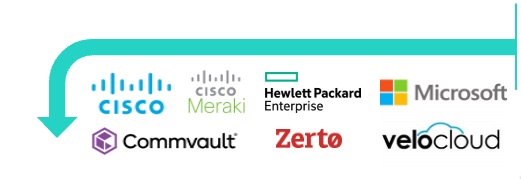Channel Partner Program
Access a wide variety of vendors, cutting-edge technologies, and advanced services

Channel program
Best-of-Breed OEMs
CBTS solutions
Awards
Elevating channel partnerships
Today’s trusted IT professional consultants and advisors hold high expectations of the partners they choose to put in front of their customers. Technology providers must meet these expectations in order to foster long term, productive relationships.
At CBTS, our channel partner program ensures mutually beneficial outcomes for trusted advisors, technology vendors, and customers. Discover how CBTS has become the go-to provider for complex customer engagements and multi-location retail deals and solving mission-critical business challenges.
Our differentiators in the Channel
CBTS by the numbers
Engineers
Technology certifications
Dedicated employees
Enterprise clients
$1B+
Annual revenue
The attributes of a trusted provider
Selecting a dependable IT services partner is essential for ensuring a positive experience and successful outcomes for your clients. These traits and our extensive industry experience embedded within our channel partner program should give you confidence in our ability to deliver high-quality solutions for your customers.
Consultative approach
Educates your customer, collaborates, and drills down to the business challenges.
Detailed project management
Respects their role, leads the process, and stays focused on the scope of engagement.
Vendor agnostic
Remains honest and upfront in making recommendations based on the best interest of the client.
Responsive and agile
We offer flexible consumption and financial models to help organizations transform and modernize.
Unbiased expertise, best-of-breed OEM solutions
CBTS provides unbiased expertise and best-of-breed OEM solutions engineered for partner success in complex MSP and MSSP environments. Specializing in AI, Security, Cloud, Networking, Voice, and Contact Center, we help partners navigate complex accounts with cutting-edge solutions and unparalleled support. As a vendor-agnostic partner, we offer honest, transparent recommendations, backed by detailed project management and flexible financial models to drive transformation. We work with top OEMs such as Cisco, Microsoft, Palo Alto Networks, Five9, Commvault, Juniper Networks, Fortinet, and many others, delivering modern technology and industry-leading results across healthcare, retail, manufacturing, finance, and professional services.
Best-of-Breed OEMs

World Class Service Provider Wrapper

Enterprise Voice, CX, & CPaaS
- MS Operator Connect
- Webex Calling
- Webex Contact Center
- Webex Connect
- Five9
- CBTS CXsync
- Avaya PS/maintenance
- Complex SIP trunking
Managed Network, SD-WAN & SASE
- Palo SD-WAN/SASE
- Palo XDR/Cortex
- Cisco Meraki SASE
- VeloCloud
- Juniper Mist
- Wi-Fi/LAN
- Circuit aggregation
- 4G/5G/LTE backup
- Circuit LOA
Cybersecurity Services
- SOC
- MDR/EDR/XDR
- Penetration testing
- Web/API testing
- Vulnerability scanning
- Patching as a Service
- NIST/ZTNA assessments
- Virtual CISO
Cloud Migration & Management
- Public/private cloud
- FINOPS consulting
- VM rightsizing
- Amazon AWS
- Microsoft Azure
- VMware/Nutanix
- Backup as a Service
- DR as a Service
Professional
Services
- LAN/Wi-Fi/Network
- Voice/SIP
- Data center/Cloud
- Application migration & modernization
- Microsoft Copilot
- AI Accelerator
- Security consulting

The Lightboard – OEM
UCaaS Retrofit: 700+ Locations in 11 Weeks
Enterprise grocery distributor: Managed Wi-Fi, SASE, UCaaS, and CCaaS
Healthcare Organization with more than 250 locations: Managed UCaaS
Three ways we stand out from the others
We enable customer success by delivering modern technologies, broad expertise, and advanced services for complex environments.
Big enough to matter, small enough to flex
Our size, experience, and a variety of technical certifications allow us to address the most complex environments.
Innovating for exceptional business outcomes
We prioritize emerging technology, embrace a customer-centric approach, and deliver business outcomes tailored to each client’s intricate needs.
Broad experience in
every industry
Solving large, complex opportunities with industry-leading solutions for healthcare, retail, manufacturing, finance, and professional service organizations.
SOLUTIONS
CBTS Strategic Solutions as a Service

“Parallel and CBTS became the single point of contact and the technology roadmap partner Donatos needed to build our Store of the Future. From supporting our corporate strategies for unified commerce and enhanced customer experience, to franchise growth, to streamlining the entirety of services and support to save us both money and time, the overall solution has certainly met our expectations.”
Larry Beckwith, Vice President of Information Services
Donatos
CBTS Awards and Recognition
Nov 2024
CBTS recognizes Megan Holtzclaw for receiving the High Tide Honor from Bluewave Technology Group
Learn more





















